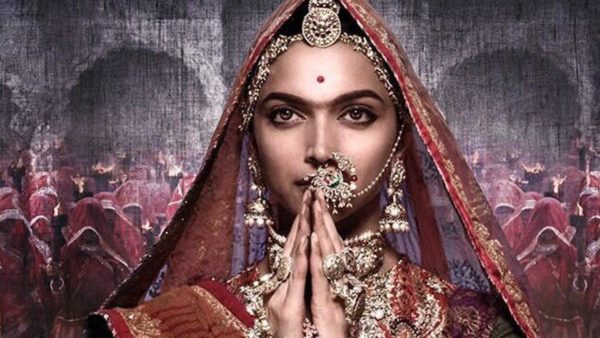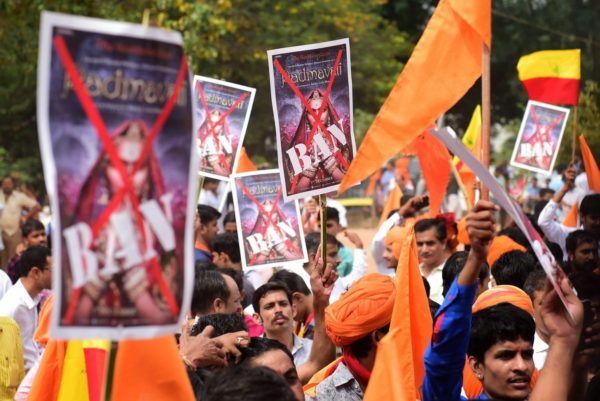by Salma Siddique
The opponents of Padmavati base their protests on rumours of a dream sequence between Padmavati and Alauddin Khilji despite Bhansali’s clarification that no such sequence exists in the film.

A recent video by Sanjay Leela Bhansali carrying a clarification on Padmavati, unlike his films, is calm and economical. In it, Bhansali says that the rumours of a dream sequence between queen Padmavati and Alauddin Khilji are incorrect and that no portrayal hurtful to the (Rajput) community’s sentiments exists in the film. The Padmavati controversy has assumed epic proportions, with death threats issued to actress Deepika Padukone and director Bhansali, with the release of the film postponed to January 2018. As the film-going public of India, including the protestors, are yet to see the film, those defending artistic expression are well within reason to dismiss the objections as baseless and motivated to foment further instability in the cauldron of Hindu-Muslim relations. This is also an occasion to reflect on the imaginative work that communities participate in, and to interpret the dream (or nightmare if you may) of a romantic scene between Padmavati and Khilji that haunts the release of Padmavati.
Admittedly, here the protestors could be keener audiences of Bhansali films than those who dismiss these anxieties as spurious. The matter at hand is not merely of disjunctions between history and legend, or pernicious representations of past events, or ensuring a freedom of creative expression at all costs (even if it means defending a film one may not necessarily endorse or enjoy,) but a recognition that what is at stake in the competing imaginations of the past, is the current now. It may turn out that Padmavati does not meet the raised expectations that progressive energies marshalled for freedom of expression inevitably engender. What is radical here, however, is this spectre – a rumour – which the release of the film will eventually settle one way or the other. If we are to understand that the dream sequence was not a publicity-driven controversy engineered by the makers of the film, and that it was never intended at any stage of its production, then where does this dream come from?
The explanation lies in Bhansali’s oeuvre: his films are visually arresting, emotionally excessive, and musically exquisite. What might get overlooked in these spectacles are the love triangles, thwarted hopes and frequent religious transgressions of the protagonists. These contraventions cause dramatic extremes that spill over and saturate the mis-en-scene. One of Bhansali’s earliest films, Khamoshi (1996), saw an Annie, going against the Catholic church and her family by falling in love with a Hindu Raj and carrying their child. In Saawariya (2007), another Raj falls in love with a Muslim Sakina who in turn pines for an inscrutable Imaan, a name that means faith. Salman Khan, who played the skull-capped, kohl-eyed character, is a star associated with a fan base of working class male Muslims and by that token, reserves the right for Eid releases in the country. The latest from the Bhansali stables was Bajirao Mastani (2015), adapting the tale of a (Maratha) Peshwa’s all-consuming passion for his second wife, the Muslim Mastani, while his first wife (a proud Maratha) suffers heartbreak stoically. Bhansali’s cinema not only involves individuals crossing religious boundaries in pursuit of modern, romantic desire but these also register the prior claims, anguish and betrayal of the surrogates (parents, betrothed, first wife) of the community whose norms are being violated. The anguish, albeit contrived, of the self-declared representatives of the Rajput community over Padmavati ironically belongs to the narrative world of Bhansali’s cinema.

To point out the lack of historical basis of Malik Muhammad Jayasi’s epic poem is futile and counter-productive: indeed, why should literary texts be excluded from constituting the social memory of a region? It is instructive to recall one of Walter Benjamin’s Theses on the Philosophy of History, where historically narrating the past involves seizing its memory as it flashes in moments of contemporary danger. The dangers and fears of contemporary India are evident in the coinages of love jihad, pinjra tod, bahu lao-beti bachao, and balatkari baba. Between urban Indian women’s desire to reclaim public spaces and sexual agency, and the public outrage over rape and sexual predation that acquires protectionist undertones, is a nation held ransom to vigilante causes and calculations of inter-religious marriages, and the shifts in identity these might entail. Padmavati’s dalliance with Khilji, the filmic space of dream notwithstanding, transforms the narrative of community honour into one of romantic desires (and yes dreams) of individuals. This imagination, even if it exists solely in the mind of the protestor, is a potent one. Surely, no one who is familiar with the conventions and codes of popular Hindi cinema will find it incongruent, if such a sequence were to exist.

Hindi cinema, which has long negotiated multi-faith sensitivities and sexual desire, also codified in the guidelines of censor certification, has done so primarily through the trope of fantasy, songs and star texts. Padmavati would have been Deepika-Ranveer’s (the two were rumoured to be in a relationship), third Bhansali film together. In Goliyon Ki Raasleela Ram-Leela (2013), the pair played the star-crossed lovers from two warring clans, while the Hindu-Muslim angle became explicit in Bajirao Mastani. In Padmavati, Bhansali dares one of the episodes central to the prism through which Hindu-Muslim relations have been routinely examined in stock Indian history. The legend has been popularly narrated as the capture of Chittor by Alauddin Khilji, after the Rajput ruler of the kingdom dies in the battlefield. As Khilji marches closer to the Chittor fort, widowed Padmavati leads a mass self-immolation of Rajput women in order to escape enslavement and dishonour by Khilji’s entourage. This tale of sexual resistance in the face of military humiliation, effectively strips Khilji of any sexual (hence masculine) allure, as Padmavati would rather embrace death than be looked at by a rapacious Sultan. In Bhansali’s Padmavati, it is the long-haired, brutish, yet wildly popular Ranveer Singh who plays Khilji to Deepika’s Padmavati. The pair’s previous film appearances as romantic leads overwhelm and unsettle the Padmavat legend. Unlike other forms of narration, the Bollywood film has placed the Rajput queen in intimate proximity with a Muslim Sultan, admitting a non-coercive dynamic, informed by the star images. Deepika may have been threatened for her criticism of the vigilantes, but these could also have been precipitated by the gossip of her romantic relationship with her co-star, thus repudiating her for a persona independent of and irreducible to the legendary character she portrays. One can contrast this with reactions to actress Deepika Chikhalia in Ramananda Sagar’s TV-series Ramayana (1987-88). The other Deepika’s immersion in the image of Sita, the epitome of chastity and conjugal devotion, was so complete that the religious minded jostled to touch her feet during public appearances.
To truly understand what is at stake here, one must grant that intimacy underpins both love and conflict. The popular Hindi cinema remained a bit wary of delving into inter-faith romances until the early 1990s – when the Hindu-Muslim romance Bombay (1995) was added to the safer combination of Hindu-Christian romances such as Bobby (1973) and Julie (1974). Much water has flown under this particular bridge with Henna (1991), Gadar (2001), Pinjar (2003), Veer Zara (2004), Kurbaan (2009), My Name Is Khan (2010), Ishaqzaade (2012), Raanjhaana (2013), Ae Dil hai Mushkil (2016), often staring at inter-faith coupling in its eye. Many a time these have been marked as exceptional by heightening the conflict either as Indo-Pak romances (Veer Zara, Henna) or partition aberrances (Gadar, Pinjar). As popular films are predominantly consumed as love stories, historicals too have pivoted around romances (Jodhaa Akbar, Mughal-I-Azam). But what happens to those histories which operate on schism, narrow communal identification and preclusion of any desire? In this sense Bhansali’s Padmavati is a dream sequence in its totality, a text very different from Jayasi’s, for while generating an internal meaning from an arrangement of cinematic time and shot, it is also anticipated by the larger history of Hindi (and Bhansali’s) cinema. In destroying the sets and assaulting the director, the opponents of the film were conveying a message right from the time Padmavati was being shot – the Hindu-Muslim conflict shall not be cinematised. The protestors recognise that a dangerous idea might emerge. We might begin to regard Padmavati and Khilji differently, for a Hindi film always ends up a romance.
_
Salma Siddique studied History at St.Stephen’s College and trained as a filmmaker at AJ Kidwai Mass Communication Research Centre, New Delhi. She completed her doctoral thesis Between Bombay and Lahore: A partition history of cinema in South Asia (1940-1960) at University of Westminster, London in 2015. During the past seven years, she has taught film theory and media production at higher education institutions in India and the UK. Her research interests include film and historical processes, film archives, auteur filmmaking from Iran, and South Asian cinemas. She is also the associate editor of the journal BioScope: Screen Studies in South Asia. In 2015 she was awarded the DRS postdoctoral fellowship at Freie University, and is
currently based in Berlin.


